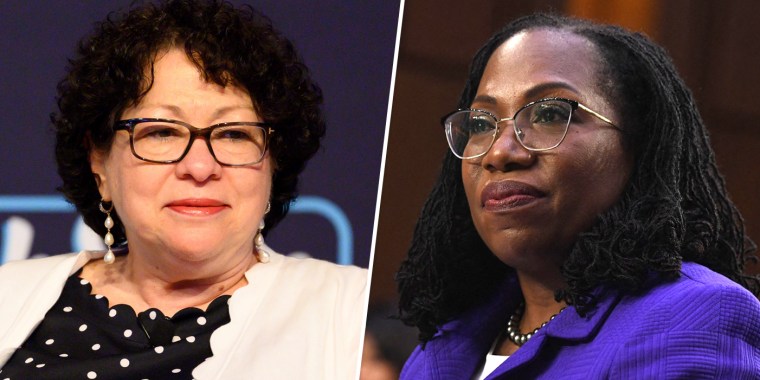Justices Sonia Sotomayor and Ketanji Brown Jackson accused their conservative colleagues on the Supreme Court of ignoring the persistent presence of racism in the United States in striking down affirmative action in college admissions on Thursday.
Sotomayor, in a 69-page dissent in a case against Harvard, characterized the court's ruling as one that “rolls back decades of precedent and momentous progress.”
In deciding “that race can no longer be used in a limited way in college admissions,” the court effectively “cements a superficial rule of colorblindness as a constitutional principle in an endemically segregated society where race has always mattered and continues to matter,” Sotomayor wrote.
Sotomayor, the third woman and the first Latina member of the court, has described herself as a “perfect affirmative action baby.” Jackson is the first Black woman on the court.
"The Court subverts the constitutional guarantee of equal protection by further entrenching racial inequality in education, the very foundation of our democratic government and pluralistic society," Sotomayor added. "Because the Court’s opinion is not grounded in law or fact and contravenes the vision of equality embodied in the Fourteenth Amendment, I dissent."
The court ruled Thursday that the University of North Carolina and Harvard violated the equal protection clause of the Constitution by considering race as a factor in the admissions process.
The vote was 6-3 in the UNC case, and 6-2 in the Harvard case.
Sotomayor dissented in both cases, while Jackson dissented in the UNC case and recused herself from the Harvard case. Jackson was on Harvard’s board of overseers until last year. Justice Elena Kagan joined both dissenting opinions.
The ruling stands to end the systematic consideration of race in the admissions process.
A society that 'has never been colorblind'
The equal protection clause was designed to preserve "a guarantee of racial equality," Sotomayor wrote, stating that previous cases have "concluded that this guarantee can be enforced through race-conscious means in a society that is not, and has never been, colorblind."
She then went in deep detail through the history of school segregation and the court precedents that have helped end such practice in K-12 education and extend that "transformative legacy to the context of higher education."
Allowing colleges and universities to consider race as one of multiple factors in the admissions process "has helped equalize educational opportunities for all students of every race and background and has improved racial diversity on college campuses," Sotomayor wrote. "Although progress has been slow and imperfect, race-conscious college admissions policies have advanced the Constitution’s guarantee of equality."
Born to a Puerto Rican family, Sotomayor grew up in a public housing project in the South Bronx. Her mother instilled in her a belief in the power of education, the justice has said.
As Sotomayor has detailed in her memoir, she excelled in school as a child while also managing a diagnosis of juvenile diabetes and other challenges. After graduating high school as valedictorian, she attended Princeton University and Yale Law School.
She eventually moved up the ranks of the judicial system until joining the Supreme Court in 2009.
Studies show students of color have higher graduation rates when they attend selective colleges, earn more after graduation and build more robust career networks.
Yet, the number of Black and Latino yearly graduates from 100 highly selective colleges that presumably use race as a factor in admissions represent only 1% of all students in four-year colleges, according to an estimate by Stanford University sociologist Sean Reardon for The New York Times.
Sotomayor concluded her dissent with the following remarks.
"The majority’s vision of race neutrality will entrench racial segregation in higher education because racial inequality will persist so long as it is ignored," she wrote. "Despite the Court’s unjustified exercise of power, the opinion today will serve only to highlight the Court’s own impotence in the face of an America whose cries for equality resound."
In a separate 29-page dissent in the UNC case, Jackson echoed some of Sotomayor's arguments, writing, "Our country has never been colorblind.”
Both justices blasted Justice Clarence Thomas for relying "on unreliable data" to inform his decision to strike down affirmative action, partly based on an assumption that Black and Latino students at elite universities underperform.
In a rather contentious and lengthy footnote from her dissent, Jackson said the Thomas opinion asks American society to continue to ignore "the elephant in the room — the race-linked disparities that continue to impede achievement of our great Nation’s full potential."
By insisting that obvious truths about racial inequality be ignored, Jackson said, the court's majority is preventing "our problem-solving institutions from directly addressing the real import and impact of 'social racism' and 'government-imposed racism,'" using phrases from Thomas' opinion.
Like Sotomayor, Jackson excelled in high school and went on to attend elite schools known to be highly selective in the admissions process.
Jackson graduated from the Radcliffe Institute for Advanced Study at Harvard University and Harvard Law School.

